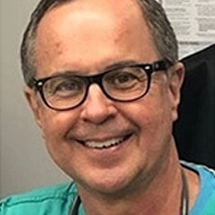
It is safe to say that few people look forward to going in for a dental procedure. The experience can be especially anxiety-producing for parents or caregivers bringing a child or an adult with special needs in for a dental procedure requiring sedation or anesthesia.
 A Certified Registered Nurse Anesthesiologist (CRNA) with decades of experience providing dental anesthesia, Steve Smith, MA, CRNA, uses open communication and empathy to dispel patients’ and parents’ fears and assure them that dental anesthesia is safe. He works with dentists, periodontists, and oral surgeons in the greater Atlanta area as well as in rural settings providing high-quality, safe, and cost-effective anesthesia.
A Certified Registered Nurse Anesthesiologist (CRNA) with decades of experience providing dental anesthesia, Steve Smith, MA, CRNA, uses open communication and empathy to dispel patients’ and parents’ fears and assure them that dental anesthesia is safe. He works with dentists, periodontists, and oral surgeons in the greater Atlanta area as well as in rural settings providing high-quality, safe, and cost-effective anesthesia.
Steve co-owns Georgia Anesthesia LLC, an office-based anesthesia practice with a staff of eight CRNAs providing anesthesia for a variety of practices ranging from orthopedic, vascular, plastic surgery, cancer treatment, ophthalmology, infertility, OB/GYN, and dental.
While Georgia Anesthesia, LLC has three CRNAs dedicated to office-based dental anesthesia, Steve handles approximately 70% of the cases himself. As a member of the American Association of Nurse Anesthesiology (AANA) Dental Advisory Panel, he emphasizes the critical importance of having a dedicated anesthesia provider to work alongside the dental provider. That allows them to focus on doing their job while the anesthesia provider keeps the patient safe and comfortable before, during, and after the procedure.
A CRNA for 39 years, Steve developed an affinity for dental anesthesia early on. “My interest originally started when I was in anesthesia school at Truman Medical Center in Kansas City, where they had an oral surgery program there,” Steve said. “I did a lot of oral surgery cases and was very comfortable doing those types of surgeries.”
Prior to a case, Steve obtains all the patient information from the dental practices, including if the patients have any history of heart disease or if there is any indication they need medical or cardiac clearance ahead of time. For the most part, he works on healthy patients ranging in age from as young as four years old to adults in their 90s!
Steve works to ease parents’ and patients’ anxiety through transparent, open communication. He explains, “As a ritual part of my routine, I call my patients the night before at home to review the anesthesia pre-op questionnaire, inform them of what they can expect, and ask if they have any questions. In cases involving pediatric patients or patients with autism, I will speak directly with the parents. I generally talk to the moms, who are the main ones who want to talk to me. The parents know their child the best, and when they are honest with me as to what the child can or cannot accept, that helps me formulate the rest of my anesthesia plan.” He also leaves it up to the parents to explain as little or as much of the procedure as they feel the child is comfortable with.
On the morning of the procedure, Steve will meet with the parents and his patient before he starts any anesthesia. He always talks to his pediatric patients by pulling up a chair or sitting beside them. He never stands over them or talks down to them. He makes sure he’s on their level.
Steve uses whichever method the parent suggests for getting their child to take the pre-op sedation medication orally, whether out of a small cup or syringe. After about 15 minutes of allowing the medication to work, he lets one of the parents, of their choosing, come back and offer support to the child or special needs patient during the induction process and starting of the IV. He said, “It’s important that the parents and the children feel they have some control.”
Steve does both intravenous conscious sedation and general anesthesia. With IV sedation, he said, “Less is more.” “I do everything I can to do a true IV conscious sedation, which I feel is the safest way to go because the patient can protect their airway.”
Steve says that most of his patients with autism tolerate conscious sedation very well. One patient he has been treating since he was 13 years old, is in his 20s today. He knows him well, and each experience with Steve as his anesthesia provider gets easier. And no matter how long he’s been taking care of a patient, he still calls the parents the night before any procedure to see if there have been any changes in the patient’s health, both physical and psychological. The parents and the patients Steve serves trust him so much they will reschedule a procedure if he can’t be their anesthesia provider.
Steve would like to get the word out that dental anesthesia is safe, an endeavor made more difficult by media stories about bad outcomes related to general anesthesia and deep sedation in dentistry. Steve notes that bad outcomes usually result from the dental provider performing the procedure and general anesthesia or deep sedation at the same time.
When deep sedation or general anesthesia is required, you need another provider dedicated to anesthesia, and safety first! CRNAs are not only cost-effective but efficient – and safe. “Some dental offices will argue about the cost. But at what point is the risk/benefit ratio detrimental to the patient’s safety? We’re talking about a small amount of money to ensure the safety and the life of a patient,” Steve says.
Steve notes that CRNAs ensure access to safe, cost-effective dental anesthesia care. Physician anesthesiologists tend to prefer to work in large urban surgery centers or hospitals. Independent CRNAs are readily available to come into an office and are not only safe and efficient but they’re also cost-effective, in most instances charging less than physician anesthesiologists.
Steve encourages other CRNAs to consider starting a dental anesthesia practice because “That’s where we’re desperately needed.” For economic and other reasons, physician anesthesiologists do not want to work in these types of settings.
Steve attributes his compassion for others, especially for children, to his years of nursing. His wife of 40 years said, “If a kid or a dog doesn’t like Steve, then there’s something wrong with them.” He said he’s a kid at heart and that helps him put himself in their shoes when dealing with his patients.
Steve might think about slowing down sometime in the future and even doing some anesthesia charity work, but for right now he’s very content making sure his dental patients are getting the safest and most cost-effective care he can provide.